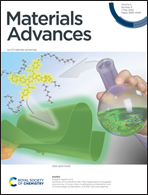Wool fabrics decorated with carbon-based conductive ink for low-voltage heaters†
Abstract
Smart textiles have extensively progressed in recent years and have expanded the potential scope and market of textiles, especially in areas of sensing, energy storage and heating. A great opportunity still exists to develop heaters based on natural fibre-based fabrics that are soft, light weight, and biodegradable. In this study, a simple, environmentally friendly, and scalable process to prepare highly conductive wool fabrics (CWFs) is reported. This multi-step process consists of stir coating and dip coating techniques using highly conductive ink based on graphene nanoplatelets (GNPs) and carbon black (CB) particles, followed by the cold-pressing process. Time-dependent temperature profiles and heat distribution analysis of the CWFs showed superior electrothermal performance to the heaters reported in the literature, reaching a surface temperature of more than 230 °C with a low applied voltage of 4.5 V (or an equivalent input power of ∼7.2 W). To demonstrate their potential application, the concept of a sandwich-structured and large size heating device was designed and the device was fabricated using a 3 × 3 array of CWFs.



 Please wait while we load your content...
Please wait while we load your content...